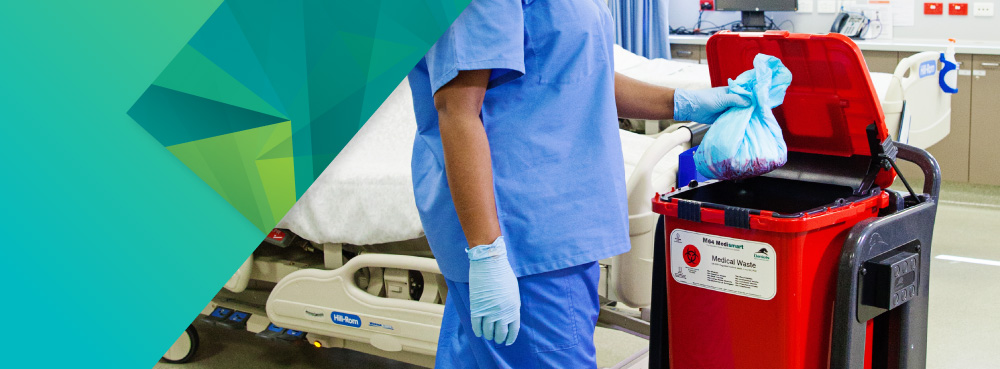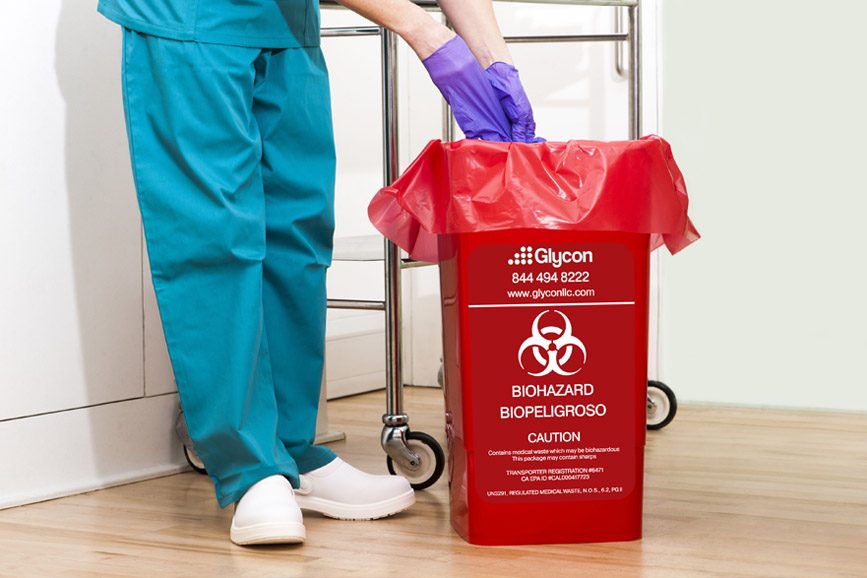The Significance of Correct Medical Garbage Disposal: An Overview for Medical Care Facilities
Correct medical garbage disposal is an important element of medical care facility monitoring, making sure the security and wellness of clients, personnel, and the atmosphere. From understanding the different categories of medical waste to abiding by regulative requirements, healthcare facilities should adopt reliable waste partition methods and choose suitable disposal approaches. However, the value of appropriate medical garbage disposal surpasses plain conformity; it is a responsibility that needs ongoing training and education for personnel. In this guide, we will certainly check out the numerous facets of medical garbage disposal and highlight the important actions that healthcare centers must take. By applying these practices, health care centers can mitigate dangers, secure public health, and contribute to a cleaner, more secure setting.
Recognizing Medical Waste Categories
Recognizing clinical waste classifications is vital for proper disposal in healthcare facilities. Medical waste is a broad term that includes various kinds of waste generated in health care setups, such as medical facilities, labs, and facilities. Classifying medical waste assists make sure that it is taken care of, stored, and disposed of securely and based on applicable policies.
There are numerous categories of medical waste that health care centers need to be knowledgeable about. These categories include infectious waste, sharps waste, pharmaceutical waste, chemical waste, and radioactive waste (medical waste disposal services with WasteX). Each classification has specific characteristics and needs different disposal techniques to reduce the threat of harm to medical care employees, clients, and the environment
Contagious waste, as an example, describes squander infected with possibly transmittable products, such as blood, body fluids, and tissues. Sharps waste consists of needles, syringes, and various other sharp things that can trigger injury or send infections. Pharmaceutical waste consists of run out or extra drugs, while chemical waste contains dangerous chemicals used in medical procedures. Lastly, radioactive waste consists of products infected with radioactive substances, such as nuclear medication products.
Compliance With Regulatory Requirements
Health care centers need to make certain compliance with governing requirements for proper clinical waste disposal. Regulatory bodies, such as the Environmental Defense Firm (EPA) and the Occupational Security and Health Administration (OSHA), have established guidelines and standards to secure public health and wellness and the atmosphere. These regulations describe the proper handling, storage, transport, and disposal of medical waste.
Conformity with regulatory needs is essential for medical care facilities to prevent lawful charges, reputational damage, and prospective damage to human wellness and the atmosphere. Failing to adhere to these policies can cause fines, legal actions, and even the suspension or revocation of operating licenses.
To make sure conformity, health care facilities need to develop detailed waste management programs that consist of personnel training, correct waste segregation, and making use of proper containers and tags. Regular audits and assessments must additionally be performed to determine any non-compliance problems and resolve them immediately.
It is crucial for medical care facilities to keep up to date with adjustments in regulations and update their waste monitoring methods accordingly. This can be accomplished by actively monitoring updates from regulatory bodies and taking part in training programs and workshops.
Executing Reliable Waste Partition Practices
To ensure appropriate clinical waste disposal, healthcare facilities need to execute efficient waste segregation practices. Waste partition is an essential action in the general waste administration procedure, as it assists lessen the threat of infection, prevents cross-contamination, and ensures the safe disposal of different sorts of waste. Effective waste partition practices include dividing medical waste right into various classifications based on its attributes and possible risks.
One usual technique is the partition of sharps waste, such as scalpels and needles, from various other sorts of medical waste. Sharps waste should be positioned in puncture-resistant containers to stop injuries and possible infections. Furthermore, dangerous waste, such as chemicals and drugs, must be separated from basic medical waste to avoid ecological contamination.
Proper labeling and color-coding of waste containers are vital for efficient waste segregation. Noticeable and clear tags need to be placed on each container to indicate the kind of waste it consists of and any Find Out More kind of unique handling demands - medical waste disposal services with WasteX. Furthermore, color-coding can be made use of to differentiate between different waste categories, making it less complicated for health care staff to determine and dispose of waste correctly
Routine training and education for healthcare team is essential for the successful implementation of waste partition methods. Personnel members ought to be educated on the various waste categories, proper partition methods, and the significance of adhering to waste monitoring protocols. This will certainly help make sure conformity and consistency in waste partition practices throughout the center.
Choosing Appropriate Disposal Methods
Appropriate selection of suitable disposal methods is necessary in guaranteeing the ecologically accountable and risk-free administration of clinical waste in medical care facilities. Health care centers create a variety of medical waste, including sharps, transmittable waste, pharmaceutical waste, and chemical waste - medical waste removal services. Each kind of waste requires certain disposal approaches to minimize the risk of contamination, injury, and ecological damage
One common disposal method for medical waste is incineration. Incineration entails the controlled burning of waste at high temperature levels.

Chemical sanitation is another method used for specific kinds of clinical waste, such as pharmaceutical waste. This approach uses chemicals to counteract or damage impurities. Nonetheless, it is necessary to pick chemicals that are eco friendly and safe.
In some instances, landfill disposal might be suitable for non-hazardous clinical waste (medical waste disposal services with WasteX). Proper partition and product packaging are important to stop leak or contamination.
Eventually, healthcare facilities must very carefully review the features of their medical waste and choose appropriate disposal techniques that prioritize security, environmental management, and regulatory conformity. Routine training and surveillance are essential to ensure that medical my explanation care team adheres to proper disposal methods.

Training and Educating Team on Appropriate Disposal Treatments
Personnel education and learning and training play a crucial duty in making sure the appropriate disposal of medical waste in health care centers. It is essential that all employee, including doctors, nurses, technicians, and support team, get extensive training on correct disposal procedures. This training must cover the various kinds of medical waste, their possible risks, and the ideal techniques for handling, segregating, and getting rid of them.
One of the key objectives of personnel education and learning and training is to make certain that all medical care experts understand the significance of proper disposal procedures and the prospective repercussions of incorrect waste monitoring. They need to be conscious of the dangers related to medical waste, such as the transmission of infections and the contamination of the environment. medical waste removal near me. By comprehending these dangers, personnel will be a lot more determined to adhere to correct disposal methods and take the essential preventative measures to secure themselves, their associates, and the neighborhood
Training must additionally cover the usage of personal safety tools (PPE) and the appropriate methods for taking care of medical waste. Employee should be informed on how to determine and segregate different sorts of waste, such as sharps, contagious waste, and unsafe chemicals. They should also be educated on the proper use of waste containers, such as sharps containers and biohazard bags, as well as the relevance of labeling and securing these containers properly.
Moreover, personnel education and training should include regular updates and refresher training courses to ensure that medical care professionals remain notified regarding the most up to date regulations and finest techniques in medical garbage disposal. This ongoing education and learning is important to preserve a high level of understanding and compliance among personnel.
Conclusion
In verdict, appropriate medical garbage disposal is of utmost significance for medical care centers. Understanding the different groups of medical waste and complying with regulative requirements makes certain the security and well-being of both medical care workers and the public. Implementing efficient waste partition methods and picking suitable disposal approaches are vital in protecting against the spread of transmittable diseases and shielding the environment. Training and informing team on appropriate disposal treatments is vital for preserving a tidy and safe medical care center.
From comprehending the various categories of medical waste to conforming with governing requirements, healthcare facilities must take on reliable waste segregation methods and choose ideal disposal techniques. These classifications consist of contagious waste, sharps waste, pharmaceutical waste, chemical waste, and radioactive waste.To guarantee correct clinical waste disposal, healthcare facilities have to implement effective waste segregation practices. Waste segregation is a crucial action in the total waste management process, as it assists decrease the risk of infection, protects against cross-contamination, and guarantees you can check here the risk-free disposal of different kinds of waste. Medical care centers generate a range of clinical waste, consisting of sharps, infectious waste, pharmaceutical waste, and chemical waste.